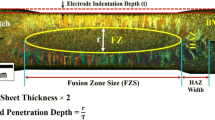Abstract
Modern advanced high-strength steel sheets for automotive applications are mostly zinc coated for corrosion resistance. However, the presence of zinc can—besides its positive effects—increase the material’s susceptibility to liquid metal embrittlement (LME) during resistance spot welding (RSW). Zinc and its eutectics are, due to their low melting point, present in liquid state during the welding process. This fact can, in combination with other factors like tensile strains or stresses, lead to the formation of brittle, intergranular cracks in the weld, and heat-affected zone. This phenomenon is commonly called liquid metal embrittlement. In order to understand the process from a practical perspective, one must learn what factors facilitate it. In this study, industry-relevant parameters are investigated regarding their influence on the occurrence of LME, embodied by the formation of surface cracks. It was found that electrode wear has less of an influence on the cracking susceptibility than welding current or tensile stresses. Finite element analysis is believed to provide a powerful tool in order to gain insights on the formation process. Modeling of the process shows promising initial results, revealing the underlying local stress and strain fields, unmeasurable with common techniques.










Similar content being viewed by others
References
Brauser S, Pepke LA, Weber G, Rethmeier M (2010) Deformation behaviour of spot-welded high strength steels for automotive applications. Mater Sci Eng A 527:7099–7108. https://doi.org/10.1016/j.msea.2010.07.091
Brauser S, Pepke LA, Weber G, Rethmeier M (2013) Influence of production-related gaps on strength properties and deformation behaviour of spot welded trip steel HCT690T. Weld World 56:115–125. https://doi.org/10.1007/BF03321342
Choi D, Uhm S, Enloe CM et al (2017) Liquid metal embrittlement of resistance spot welded 1180TRIP steel—effects of crack geometry on weld mechanical performance. 2017:454–462. https://doi.org/10.7449/2017/MST
Rethmeier M (2014) Influence of weld imperfections on the fatigue behavior of resistance spot welded advanced high strength steels. Adv Mater Res 891, 892:1445–1450
Tolf E, Hedegård J, Melander A (2013) Surface breaking cracks in resistance spot welds of dual phase steels with electrogalvanised and hot dip zinc coating. Sci Technol Weld Join 18:25–31. https://doi.org/10.1179/1362171812Y.0000000068
VEREIN DEUTSCHER INGENIEURE (2017) Schadensanalyse Flüssigmetallinduzierte Rissbildung. Vdi-richtlin 3822:1–2
Joseph B, Picat M, Barbier F (1999) Liquid metal embrittlement: a state-of-the-art appraisal. Eur Phys J Appl Phys
Westwood ARC, Preece CM, Kamdar MH (1967) Adsorption-induced brittle fracture in liquid metal environments. Clearinghouse, Baltimore
Kamdar MH (1983) Liquid metal embrittlement. In: Briant CL, Banerji SK (eds) Treatise mater. Sci Technol, pp 361–459
Fernandes PJL, Clegg RE, Jone DRH (1994) Failure by liquid metal induced embrittlement. Eng Fail Anal 1:51–63
Zhang H, Senkara J (2006) Resistance welding—fundamentals and application. J Chem Inf Model. https://doi.org/10.1017/CBO9781107415324.004
Sigler DR, Schroth JG, Yang W (2008) Observations of liquid metal-assisted cracking in resistance spot welds of zinc-coated advanced high-strength steels. In: Sheet Met. Weld. Conf. pp 1–9
Beal C, Kleber X, Fabregue D, Bouzekri M (2012) Liquid zinc embrittlement of twinning-induced plasticity steel. Scr Mater 66:1030–1033. https://doi.org/10.1016/j.scriptamat.2011.12.040
Nicholas MGG, Old CFF, Division MD (1979) Review liquid metal embrittlement. J Mater Sci 14:1–18. https://doi.org/10.1007/BF01028323
Gordon P (1978) Metal-induced embrittlement of metals—an evaluation of embrittler transport mechanisms. Metall Trans A 9:267–273. https://doi.org/10.1007/BF02646710
Joseph B, Picat M, Barbier F (1999) Liquid metal embrittlement: a state-of-the-art appraisal. Eur Phys J Appl Phys 15(1):19–31
Ernst W (2016) Widerstandspunktschweißen von metallisch und organisch beschichteten Stahlfeinblechen. Technische Universität Graz
Frei J, Suwala H, Gumenyuk A, Rethmeier M (2016) Bestimmung der Rissanfälligkeit von hochfesten Stählen beim Widerstandspunktschweißen. Mater Test 58:7–8. https://doi.org/10.3139/120.110904
Gaul H, Brauser S, Weber G, Rethmeier M (2011) Methods to obtain weld discontinuities in spot-welded joints made of advanced high-strength steels. Weld World 55:99–106. https://doi.org/10.1007/BF03321547
(2011) Stahl-Eisen-Prüfblatt 1220: Prüf- und Dokumentationsrichtlinie für die Fügeeignung von Feinblechen aus Stahl
R.H. W (1996) Confocal optical microscopy: reports on progress in physics. Rep Prog Phys 59:427–471
Rethmeier M, Suwala H, Frei J (2017) Schlussbericht zum IGF Vorhaben Nr. P 921 / S 024/10197/12: “Entwicklung eines Verfahrens zur Bestimmung der Rissanfälligkeit von hochfesten Stählen beim Widerstandspunktschweißen”
Acknowledgements
The authors want to thank the voestalpine Steel Division for provision of testing materials and fruitful discussions.
Author information
Authors and Affiliations
Corresponding author
Additional information
Recommended for publication by Select Committee AUTO - Automotive and Road Transport
Rights and permissions
About this article
Cite this article
Frei, J., Rethmeier, M. Susceptibility of electrolytically galvanized dual-phase steel sheets to liquid metal embrittlement during resistance spot welding. Weld World 62, 1031–1037 (2018). https://doi.org/10.1007/s40194-018-0619-1
Received:
Accepted:
Published:
Issue Date:
DOI: https://doi.org/10.1007/s40194-018-0619-1




